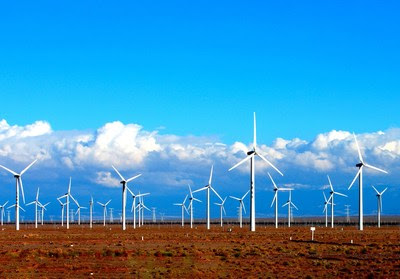Tuesday marks the first-ever U.S. auction of leases to develop commercial-scale floating wind farms in the deep waters off the West Coast.
The live, online auction for the five leases — three off California’s central coast and two off its northern coast — has attracted strong interest and 43 companies from around the world are approved to bid. The wind turbines will float roughly 25 miles offshore.
The growth of offshore wind comes as climate change intensifies and the need for clean energy grows. It also is getting cheaper. The cost of developing offshore wind has dropped 60% since 2010 according to a July report by the International Renewable Energy Agency. It declined 13% in 2021 alone.
Offshore wind is well established in the U.K. and some other countries but is just beginning to ramp up off America’s coasts, and this is the nation’s first foray into floating wind turbines. Auctions so far have been for those anchored to the seafloor.
Europe has some floating offshore wind — a project in the North Sea has been operating since 2017 — but the potential for the technology is huge in areas of strong wind off America’s coasts, said Josh Kaplowitz, vice president of offshore wind at the American Clean Power Association.
“We know that this works. We know that this can provide a huge slice of our electricity needs, and if we’re going to solve the climate crisis we need to put as many clean electrons online as we can, particularly given increases in load demand with electric vehicles,” he said. “We can reach our greenhouse gas goals only with offshore wind as part of the puzzle.”
Similar auctions are in the works off Oregon’s coast next year and in the Gulf of Maine in 2024. President Joe Biden set a goal of deploying 30 gigawatts of offshore wind by 2030 using traditional technology that secures wind turbines to the ocean floor, enough to power 10 million homes. Then the administration announced plans in September to develop floating platforms that could vastly expand offshore wind in the United States.
The California sale is designed to promote a domestic supply chain and create union jobs. Bidders can convert part of their bids into credits that benefit those affected by the wind development — local communities, tribes and commercial fishermen.
As envisioned, the turbines — possibly nearly as tall as the Eiffel Tower — will float on giant triangular platforms roughly the size of a small city block or buoyant cylinders with cables anchoring them underwater.
They’ll each have three blades longer than the distance from home plate to the outfield on a baseball diamond, and will need to be assembled onshore and towed, upright, to their open-ocean destination.
Modern tall turbines, whether on or offshore, can produce more than 20 times more electricity than shorter machines, say, from the early 1990s.
As for visibility, “in absolutely perfect conditions, crystal clear on the best days, at the highest point, you might be able to see small dots on the horizon,” said Larry Oetker, executive director of the Humboldt Bay Harbor, Conservation and Recreation District, which has been preparing its deep-water port for the projects.
Offshore wind is a good complement to solar energy, which shuts down at night. Winds far out to sea are stronger and more sustained and also pick up in the evening, just when solar is going offline yet demand is high, said Jim Berger, a partner at the law firm Norton Rose Fulbright who specializes in financing renewable energy projects.
California has a 2045 goal of carbon neutrality. But “when the sun goes down, we’re relying more on fossil fuel generation,” Berger said. “These projects are huge so when you add a project or a couple projects, you’re adding significantly to the power generation base in the state,” he said.
The lease areas have the potential to generate 4.5 gigawatts of energy, enough for 1.5 million homes, and could bring big changes to communities in the rural coastal regions nearest the leases.
But some are also wary of the projects, despite favoring a transition to clean energy.
Environmentalists are concerned about the impacts on threatened and endangered whales, which could become entangled in the cables that will anchor the turbines. There are also concerns about birds and bats colliding with the turbine blades and whales being struck by vessels towing components to the site. Federal regulators have set a boating speed limit for the project of less than 12 mph to address that concern, said Kristen Hislop, senior director of the marine program at the Environmental Defense Center.
Tribes in the vast coastal regions also worry about damage to their ancestral lands from turbine assembly plants and transmission infrastructure. They fear that the farms will be visible on clear days from sacred prayer spots high in the mountains.
Source: Voice of America




